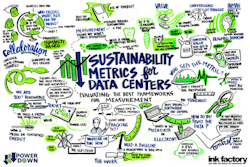2022: The Year of Data Center Sustainability Metrics
In this edition of Voices of the Industry, Sean Farney, Director of Data Center Marketing at Kohler Data Centers explores the pressing needs that data centers have around sustainability metrics.
Sean Farney, Director of Data Center Marketing at Kohler Data Centers
Back in February of this year, I wrote about how the old data center power efficiency standard, PUE, was due for an upgrade. Somewhat tongue-in-cheek, I proposed we create the moniker “GUE” (Green Usage Efficiency) as the new industry buzzword to chase and compete on.
As it turns out, the industry does appear to be hungry for a new set of metrics. As data center providers achieve greater sustainability thresholds across more than just power systems, they yearn for a way to capture, report, and track it. After all, we can’t manage what we don’t measure – and boy do data center critical environments folks like to measure!
This need to measure sustainability across more than just the typical ecosystem of power components – the entire “data center biosphere,*” if you will – was no more apparent than at the first annual Power Down data center executive retreat in October. Kohler and Schneider Electric brought over 30 digital infrastructure luminaries to the American Club to ferret out industry challenges, propose solutions, and map out potential next steps (we may have also spent some time on Whistling Straits). The theme of this year’s gathering was “Getting Green,” capturing the high-visibility and urgency of the sustainability imperative.
In one breakout, our whiteboard session yielded an amazing capture of the both the pressing need for and complexity of sustainability metrics:
Source: Kohler Data Centers
The fine print is fascinating. The call-outs range from concretely tactical “audit the electron” to high-level strategic “want a metric on consumed energy,” then transcend to philosophical “who decides what’s best for the world.” We follow these highlights like a trail of thought-provoking breadcrumbs, eager for more as we pursue the path to a sustainable digital future.
What can we conclude from all this enthusiasm for data center sustainability? I think it’s safe to say that since top industry leaders are clamoring for next steps, there is sufficient interest and activation energy to force movement in 2022. And from the intense focus on operational inputs recorded above – measurement, reporting, capture, metrics, baselines – my money is on Operations to be the first movers. In fact, I recently saw a blog post from Salute Mission Critical evangelizing the sustainability benefits of highly optimized data center operations. It’s no surprise that a world-class provider of critical environment services can translate their extensive global experience in the field into increased efficiency. In the past this added efficiency was a fringe benefit of running a tight ship, whereas now it appears that sustainability is starting to be productized! But this makes perfect sense. Solutioneering at the operational-level confirms what we heard from industry leaders when we came together in October: we need a large, holistic, “biosphere” approach that includes, but supersedes PUE, and starts at the fundamental level.
What’s even more interesting is that this movement follows the greater Enterprise direction for sustainability. When assessing corporate emissions and impact, the EPA measures three different areas, or scopes. Scopes 1 and 2 focus on inputs – emissions from purchased power sources. But Scope 3 focuses on assets not owned or controlled by the purchasing organization, its entire product value chain i.e., outputs. For example, Kohler manufactures a line of water saving plumbing products called WaterSense, which have saved 292 billion gallons of water for customers since 2007. The data center industry may be well on its way to a similar pursuit of Scope 3 gains, measuring and efficientizing operational outputs as the next evolution in reducing industry environmental impact. This pursuit would lead to a new arms race, in the best kind of way, to use operational levers to reduce energy consumption and particulate emissions.
*Credit for the term belongs to industry expert and friend Joe Reele
Sean Farney, a data center geek with Hyperscale operating experience, is the Director of Data Center Marketing at Kohler Data Centers. Read Kohler’s latest white paper here.


